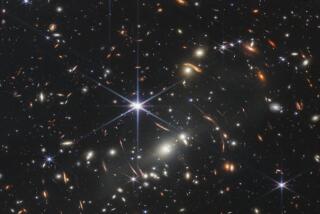In the dark of space, enlightenment waits
- Share via
IF ALL GOES as planned, an American spacecraft, New Horizons, will blast off today for the outer reaches of the solar system, its mission to boldly go where no craft has gone before.
If it’s successful, this will be the end of the beginning of human exploration of the solar system. For with this mission, we attempt to finish something that we started in 1962 -- taking a first look around our planetary neighborhood. In August of ‘62, Mariner 2 was launched for a quick rendezvous with nearby Venus, zipping by at a distance of 22,000 miles, scanning its radiation field and proving that a terminal case of global warming had completely ruined its surface for our kind of life.
That fly-by ushered in nearly half a century of interplanetary visitations of historic, even evolutionary significance. About 4.6 billion years after Earth and a handful of planet siblings were assembled by random collisions of rock, metal and ice, our planet began flinging small bits of itself back out into the darkness, trying to satisfy a newly evolved curiosity with fragile machines equipped with cameras and radio transmitters. It took so long because first there had to be a species with the audacity to think that it could build such contraptions, calculate their trajectories and make them fly.
We did it. There is no more solid, visceral confirmation of the truths embodied by the Enlightenment and the scientific revolution. If our ideas about other planets are merely a “text” to be deconstructed, or another creation story to debate, if they are culturally determined, internally constructed, dreamed, projected or imagined, then why are the planets there, right there, where we thought they would be?
Since Mariner 2 our aim has only gotten better, our confidence has increased and our explorations have become more ambitious. The first forays to the seven planets we have visited thus far -- Venus, Mars, Mercury, Jupiter, Saturn, Uranus and Neptune -- were all fly-by missions in which you just try to get close and then, as you take that first precious look, you measure what you can and radio the news back to Earth. We later returned to many of these worlds with orbiters to do global mapping, entry probes to sniff the air and landers to test the rocks and take photographs. So far we’ve commenced real surface exploration just on Mars and our own moon. The next step is bringing samples back to Earth for study; the successful landing of the Stardust capsule on Sunday shows the way.
New Horizons, heading for Pluto, more than 30 times Earth’s distance from the sun, is once again a fly-by and a “last first.” This is the last time we will first set sail for an entirely new realm of our planetary system -- in this case the cold outer reaches where the only worlds are small orbs of frozen water, nitrogen and methane, and where our sun shines 1,000 times dimmer and its diminished gravitational force pulls planets on slow orbits taking hundreds of years.
The closer we get to Pluto, the closer we may get to an end to the semantic argument over whether it’s a planet or not. There is the New York School, which holds that only giant “metropolitan” worlds are worthy of planet status. I favor the Boulder (Colo.) School, which holds that small, widely scattered places deserve just as much respect. If there are, as seems likely, hundreds or thousands of these distant “ice dwarf” planets in our system, we should feel enlarged, not diminished, by this news.
PLUTO IS READY for its close-up, but getting there will require patience. The launch of New Horizons will be the fastest ever, with the spacecraft fleeing Earth at 36,000 mph. Still, it takes a long time to travel 4 billion miles. In 13 months, the craft will get to Jupiter, where it will make some quick observations while using that massive planet as a gravitational spring, flinging itself out toward Pluto and its moons, where it will finally arrive in 2015.
Nine years represents a significant chunk of lives and careers. Who of us will be around to see the data? Will the spacecraft survive the long cruise into the cold and dark?
In 2015, we expect patience to be rewarded when we find lost clues to our own origins preserved from the earliest days of planetary formation. We expect to be surprised in ways that will make us rewrite the planetary science books, just as Galileo, the Jupiter orbiter, and Cassini, now orbiting Saturn, have turned up geologic activity that has destroyed our previous ideas about planetary formation and evolution.
Theory alone cannot teach us what there is to know. The universe is stranger and more varied than we can predict or calculate, and that is why we explore. We can’t know exactly what New Horizons will find. But we can safely predict that when we get to Pluto -- and the whole new class of worlds it represents -- what we discover will baffle, surprise, delight and enlighten.






